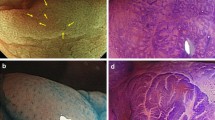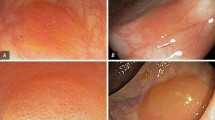Abstract
Background
A sessile-serrated adenoma (SSA) has a high risk for incomplete resection. Little is known regarding how to immediately detect remnant SSA tissue after endoscopic resection. We investigated the usefulness of narrow-band imaging (NBI) to detect remnant SSA tissue after endoscopic mucosal resection (EMR).
Methods
We performed a prospective randomized study on 138 patients who had suspicious SSA on colonoscopy at five centers. After EMR on the suspected SSA determined on the endoscopic morphology, all lesions were randomized into two inspection methods, NBI and white light endoscopy (WLE), to detect remnant tissue on the resected margin. If remnant tissue was detected, an additional resection was performed. Finally, we obtained quadrant biopsies on the resection margin to evaluate the incomplete resection. The proportion of incomplete resection was calculated by combining the detection of remnant tissue and the positivity of SSA cells on the final quadrant biopsies. The primary outcome was the proportion of remnant tissue detection, and the secondary outcome was the proportion of incomplete resection of SSA.
Results
In all, 145 lesions from 138 patients were removed. The diagnostic rate of SSA was 87.6% (127/145). After randomization, NBI inspection was performed on 69 lesions, and WLE inspection was performed on 76 lesions. The histologic diagnostic rate of SSA was 89.9% (62/69) in the NBI group and 85.5% (65/76) in the WLE group (p > 0.05). There were no significant differences in the detection of remnant tissue (12.9% (8/62) vs. 15.4% (10/65), p > 0.05), the proportion of SSA in remnant tissue (11.3% (7/62) vs. 12.3% (8/65), p > 0.05), or the proportion of incomplete resection (6.5 (4/62) vs. 10.8 (7/65), p > 0.05) between the NBI and WLE inspection groups, respectively.
Conclusion
NBI was not superior to WLE for detecting remnant SSA tissue after EMR and could not decrease the proportion of incomplete resection of SSA.



Similar content being viewed by others
References
Hiraoka S, Kato J, Fujiki S, Kaji E, Morikawa T, Murakami T, Nawa T, Kuriyama M, Uraoka T, Ohara N, Yamamoto K (2010) The presence of large serrated polyps increases risk for colorectal cancer. Gastroenterology 139:1503–1510
Tadepalli US, Feihel D, Miller KM, Itzkowitz SH, Freedman JS, Kornacki S, Cohen LB, Bamji ND, Bodian CA, Aisenberg J (2011) A morphologic analysis of sessile serrated polyps observed during routine colonoscopy (with video). Gastrointest Endosc 74:1360–1368
Kambara T, Simms LA, Whitehall VL, Spring KJ, Wynter CV, Walsh MD, Barker MA, Arnold S, McGivern A, Matsubara N, Tanaka N, Higuchi T, Young J, Jass JR, Leggett BA (2004) BRAF mutation is associated with DNA methylation in serrated polyps and cancers of the colorectum. Gut 53:1137–1144
Boparai KS, Mathus-Vliegen EM, Koornstra JJ, Nagengast FM, van Leerdam M, van Noesel CJ, Houben M, Cats A, van Hest LP, Fockens P, Dekker E (2010) Increased colorectal cancer risk during follow-up in patients with hyperplastic polyposis syndrome: a multicentre cohort study. Gut 59:1094–1100
Edelstein DL, Axilbund JE, Hylind LM, Romans K, Griffin CA, Cruz-Correa M, Giardiello FM (2013) Serrated polyposis: rapid and relentless development of colorectal neoplasia. Gut 62:404–408
Jaramillo E, Tamura S, Mitomi H (2005) Endoscopic appearance of serrated adenomas in the colon. Endoscopy 37:254–260
Hazewinkel Y, Tytgat KM, van Leerdam ME, Koornstra JJ, Bastiaansen BA, van Eeden S, Fockens P, Dekker E (2015) Narrow-band imaging for the detection of polyps in patients with serrated polyposis syndrome: a multicenter, randomized, back-to-back trial. Gastrointest Endosc 81:531–538
Pohl H, Srivastava A, Bensen SP, Anderson P, Rothstein RI, Gordon SR, Levy LC, Toor A, Mackenzie TA, Rosch T, Robertson DJ (2013) Incomplete polyp resection during colonoscopy-results of the complete adenoma resection (CARE) study. Gastroenterology 144:74–80
Chino A, Nagayama S, Ishikawa H, Morishige K, Kishihara T, Arai M, Sugiura Y, Motoi N, Yamamoto N, Tamegai Y, Igarashi M (2016) Cancer emerging from the recurrence of sessile serrated adenoma/polyp resected endoscopically 5 years ago. Jpn J Clin Oncol 46:89–95
Boparai KS, van den Broek FJ, van Eeden S, Fockens P, Dekker E (2011) Increased polyp detection using narrow band imaging compared with high resolution endoscopy in patients with hyperplastic polyposis syndrome. Endoscopy 43:676–682
Yamada M, Sakamoto T, Otake Y, Nakajima T, Kuchiba A, Taniguchi H, Sekine S, Kushima R, Ramberan H, Parra-Blanco A, Fujii T, Matsuda T, Saito Y (2015) Investigating endoscopic features of sessile serrated adenomas/polyps by using narrow-band imaging with optical magnification. Gastrointest Endosc 82:108–117
Park SK, Ko BM, Han JP, Hong SJ, Lee MS (2016) A prospective randomized comparative study of cold forceps polypectomy by using narrow-band imaging endoscopy versus cold snare polypectomy in patients with diminutive colorectal polyps. Gastrointest Endosc 83:527–532
Parikh ND, Chaptini L, Njei B, Laine L (2016) Diagnosis of sessile serrated adenomas/polyps with image-enhanced endoscopy: a systematic review and meta-analysis. Endoscopy 48:731–739
Aziz M, Desai M, Hassan S, Fatima R, Dasari CS, Chandrasekar VT, Jegadeesan R, Duvvuri A, Patel H, Rai T, Sathyamurthy A, Kohli DR, Vennalaganti P, Nawras A, Wallace M, Sharma P (2019) Improving serrated adenoma detection rate in the colon by electronic chromoendoscopy and distal attachment: systematic review and meta-analysis. Gastrointest Endosc 90:721–731
Yamashina T, Takeuchi Y, Uedo N, Aoi K, Matsuura N, Nagai K, Matsui F, Ito T, Fujii M, Yamamoto S, Hanaoka N, Higashino K, Ishihara R, Tomita Y, Iishi H (2015) Diagnostic features of sessile serrated adenoma/polyps on magnifying narrow band imaging: a prospective study of diagnostic accuracy. J Gastroenterol Hepatol 30:117–123
Uraoka T, Higashi R, Horii J, Harada K, Hori K, Okada H, Mizuno M, Tomoda J, Ohara N, Tanaka T, Chiu HM, Yahagi N, Yamamoto K (2015) Prospective evaluation of endoscopic criteria characteristic of sessile serrated adenomas/polyps. J Gastroenterol 50:555–563
Kim ER, Jeon J, Lee JH, Lee YJ, Hong SN, Chang DK, Kim YH (2017) Clinical characteristics of patients with serrated polyposis syndrome in Korea: comparison with Western patients. Intest Res 15:402–410
Abeygunaratne T, Herrick A, Chinoy H, Sowden E, Choudhury J, Sinha S (2016) Simple tool in a complex case: use of the nailfold capillaroscopy. Kidney Int 89:1168
Tate DJ, Jayanna M, Awadie H, Desomer L, Lee R, Heitman SJ, Sidhu M, Goodrick K, Burgess NG, Mahajan H, McLeod D, Bourke MJ (2018) A standardized imaging protocol for the endoscopic prediction of dysplasia within sessile serrated polyps (with video). Gastrointest Endosc 87:222–231
IJspeert JEG, Bastiaansen BA, van Leerdam ME, Meijer GA, van Eeden S, Sanduleanu S, Schoon EJ, Bisseling TM, Spaander MC, van Lelyveld N, Bargeman M, Wang J, Dekker E, Dutch Workgroup serrAted polyp S, Polyposis (2016) Development and validation of the WASP classification system for optical diagnosis of adenomas, hyperplastic polyps and sessile serrated adenomas/polyps. Gut 65:963–970
Rex DK, Clodfelter R, Rahmani F, Fatima H, James-Stevenson TN, Tang JC, Kim HN, McHenry L, Kahi CJ, Rogers NA, Helper DJ, Sagi SV, Kessler WR, Wo JM, Fischer M, Kwo PY (2016) Narrow-band imaging versus white light for the detection of proximal colon serrated lesions: a randomized, controlled trial. Gastrointest Endosc 83:166–171
Tutticci NJ, Hewett DG (2018) Cold EMR of large sessile serrated polyps at colonoscopy (with video). Gastrointest Endosc 87:837–842
Funding
This work was supported by the Soonchunhyang University Research Fund.
Author information
Authors and Affiliations
Contributions
HGK and JSB contributed equally to this article. YJ and JRM: Analysis and interpretation of data; writing up of the first draft of the paper. HGK, JSB: Study concept and design; Patient recruitment; SYP: Analysis and interpretation of data; Critical revision of the manuscript for important intellectual content. SRJ, JMC, HJY: Patient recruitment; Analysis and interpretation of data; Critical revision of the manuscript for important intellectual content.
Corresponding authors
Ethics declarations
Disclosures
Dr. Yunho Jung, Dr. Jung Rock Moon, Dr. Seong Ran Jeon, Dr. Jae Myung Cha, Dr. Hyo-Joon Yang, Dr. Suyeon Park, RN. Yumi Ahn, Dr. Jeong-Sik Byeon, MD and Dr. Hyun Gun Kim have no conflict of interest or financial ties to disclose.
Additional information
Publisher's Note
Springer Nature remains neutral with regard to jurisdictional claims in published maps and institutional affiliations.
Rights and permissions
About this article
Cite this article
Jung, Y., Moon, J.R., Jeon, S.R. et al. Usefulness of narrow-band imaging for the detection of remnant sessile-serrated adenoma (SSA) tissue after endoscopic resection: the KASID multicenter study. Surg Endosc 35, 5217–5224 (2021). https://doi.org/10.1007/s00464-020-08016-2
Received:
Accepted:
Published:
Issue Date:
DOI: https://doi.org/10.1007/s00464-020-08016-2




